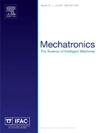3D coordinate sensing with nonsmooth friction dynamical discontinuities compensation in laser scanning system
IF 3.1
3区 计算机科学
Q2 AUTOMATION & CONTROL SYSTEMS
引用次数: 0
Abstract
This study aimed to address the issue of laser ray spatial positioning to mitigate discontinuities in the dynamics caused by nonsmooth friction effects by the direct application of control theory with improved friction compensation. Analyzing physical phenomena on micro-relieved surfaces through SEM methods, the obtained data about surface characteristics helps synthesize a corresponding control law for the laser positioner and conduct its stability analysis. This work considers a patented laser scanning system incorporating a laser positioning mechanism with inherent friction. SEM micrograph analysis of the friction zone was conducted to compare microscopic imperfections of steel surfaces, which helped infer the dynamics of an internal variable ‘z’ in the friction model and determine a reference value for control synthesis. A nonlinear control algorithm was proposed to compensate for friction to enhance positioning accuracy. The global asymptotic stability of the system was proven using Lyapunov’s direct method and Barbalat’s lemma. Experimental implementation on an STM32 board demonstrated a significant reduction in the uncertainty associated with sensing 3D coordinates using the friction-compensated laser scanning system.

激光扫描系统中非光滑摩擦动态不连续补偿的三维坐标传感
本研究旨在通过直接应用控制理论和改进的摩擦补偿,解决激光射线空间定位问题,以减轻非光滑摩擦效应引起的动力学不连续。通过扫描电子显微镜(SEM)方法对微浮雕表面的物理现象进行分析,得到的表面特性数据有助于综合相应的激光定位器控制规律并进行稳定性分析。这项工作考虑了一种专利激光扫描系统,该系统结合了具有固有摩擦的激光定位机构。对摩擦区进行了SEM显微图分析,以比较钢表面的微观缺陷,这有助于推断摩擦模型中内部变量“z”的动力学,并确定控制综合的参考值。为了提高定位精度,提出了一种补偿摩擦的非线性控制算法。利用Lyapunov的直接方法和Barbalat引理证明了系统的全局渐近稳定性。在STM32板上的实验实现表明,使用摩擦补偿激光扫描系统可以显著降低与传感3D坐标相关的不确定性。
本文章由计算机程序翻译,如有差异,请以英文原文为准。
求助全文
约1分钟内获得全文
求助全文
来源期刊

Mechatronics
工程技术-工程:电子与电气
CiteScore
5.90
自引率
9.10%
发文量
0
审稿时长
109 days
期刊介绍:
Mechatronics is the synergistic combination of precision mechanical engineering, electronic control and systems thinking in the design of products and manufacturing processes. It relates to the design of systems, devices and products aimed at achieving an optimal balance between basic mechanical structure and its overall control. The purpose of this journal is to provide rapid publication of topical papers featuring practical developments in mechatronics. It will cover a wide range of application areas including consumer product design, instrumentation, manufacturing methods, computer integration and process and device control, and will attract a readership from across the industrial and academic research spectrum. Particular importance will be attached to aspects of innovation in mechatronics design philosophy which illustrate the benefits obtainable by an a priori integration of functionality with embedded microprocessor control. A major item will be the design of machines, devices and systems possessing a degree of computer based intelligence. The journal seeks to publish research progress in this field with an emphasis on the applied rather than the theoretical. It will also serve the dual role of bringing greater recognition to this important area of engineering.
 求助内容:
求助内容: 应助结果提醒方式:
应助结果提醒方式:


